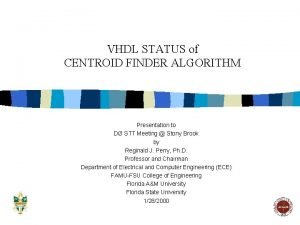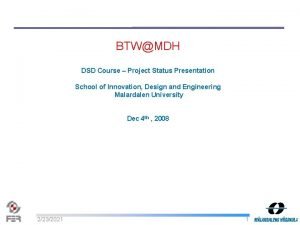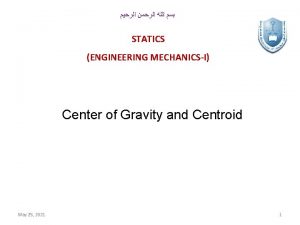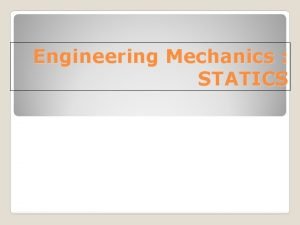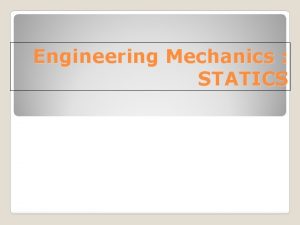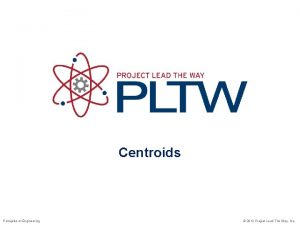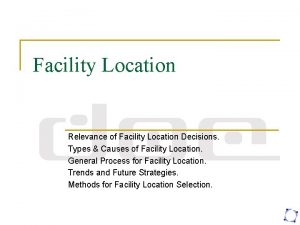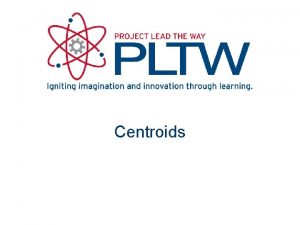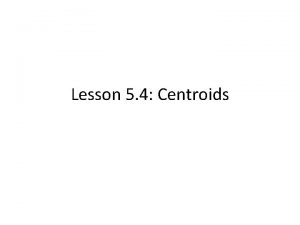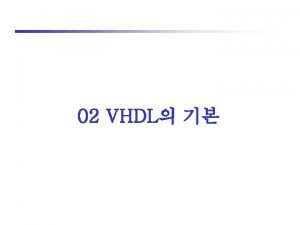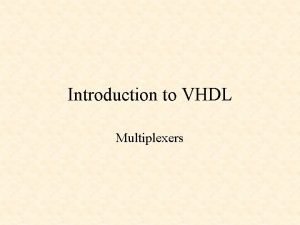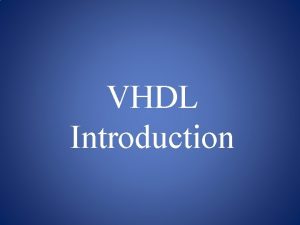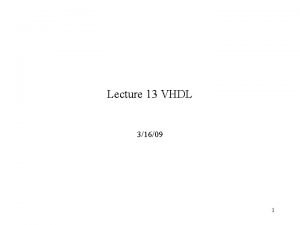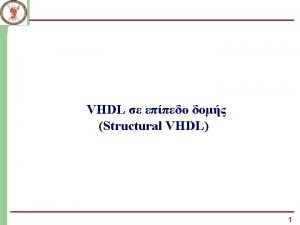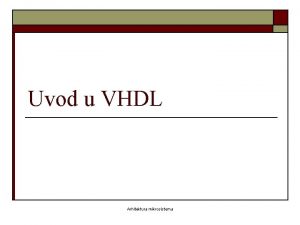VHDL STATUS of CENTROID FINDER ALGORITHM Presentation to












- Slides: 12

VHDL STATUS of CENTROID FINDER ALGORITHM Presentation to DØ STT Meeting @ Stony Brook by Reginald J. Perry, Ph. D. Professor and Chairman Department of Electrical and Computer Engineering (ECE) FAMU-FSU College of Engineering Florida A&M University Florida State University 1/28/2000

Background and Design Objective n n n Contacted in early December 1999 by Dr. Wahl. Recruited two (2) new graduate students to work on project – Shweta Lolage – full-time GRA. – Kishma Meyers – part time – Roberto Brown - part time Discussed initial algorithm with Eric Hazen just before Christmas 1999 – Working documents • Earle, “A State Machine for Input of VTM Data to the Centroid Finder”, 7/20/99 • Earle, “A Flowchart for the Centroid Finder”, 9/3/99 n Initial Design Objective – Complete baseline functional design by today’s meeting • Conservative design, i. e. Ignore timing constraints • No “Bells or Whistles” D 0 STT Meeting at Stony Brook VHDL Status

Design Process n n n Altera FPLDs Default Synthesis Settings Partition Design into three parts – 1. Decoder • VTM FIFO • Preprocessor FSM • Centroid Finder FIFO – 2. Buffer Filler • Centroid Finder Algorithm minus “Calculator. ” – 3. Calculator • Computes 13 bit centroid address D 0 STT Meeting at Stony Brook VHDL Status

Block Diagram Fifo data Vtm 8 Decoder 22 Fifo empty Buffer Filler rdreq D 1 -D 5 35 datavalid busy D 0 STT Meeting at Stony Brook VHDL Status datatype Calculator 2 pointer 13

Decoder Block D 0 STT Meeting at Stony Brook VHDL Status

Buffer Filler Block D 0 STT Meeting at Stony Brook VHDL Status

Calculator Block D 0 STT Meeting at Stony Brook VHDL Status

Functional Simulation Assumptions • • 1 MHz Clock Single Chip No Bad Channels No Skipped Channels D 0 STT Meeting at Stony Brook VHDL Status

Sample Input Data and Expected Output Results D 0 STT Meeting at Stony Brook VHDL Status

Functional Simulation D 0 STT Meeting at Stony Brook VHDL Status

Resource Allocation Device EPF 10 K 50 EQC 208 -1 Total logic cells used: Total embedded cells used: Total EABs used: Average fan-in: 1433/2880 ( 49%) 40/160 ( 25%) 8/10 ( 80%) 3. 24/4 Total flipflops required: ( 81%) 481 D 0 STT Meeting at Stony Brook VHDL Status

Current Status n Baseline Design Completed and Documented. n Static Timing Analysis of Baseline Design showed 30 MHz Maximum Clock Freq – Performance limited by Buffer Filler Module. n Beginning Revision 2 Design based on Earle, et. al. , “Specifications for the STC Daughtercard” – – Add Hit Filter Add 3 or 5 strip cluster finder option Examine PCI bus interface Add L 3 buffer/monitoring requirements. D 0 STT Meeting at Stony Brook VHDL Status
 Centroid finder
Centroid finder Project status presentation
Project status presentation Center of gravity statics
Center of gravity statics Static mechanics
Static mechanics If m is a centroid of triangle wor and wm = 16, what is wx?
If m is a centroid of triangle wor and wm = 16, what is wx? Centroid in engineering mechanics
Centroid in engineering mechanics Statics centroid
Statics centroid Centroid of complex shapes
Centroid of complex shapes Differentiate between centre of mass and centre of gravity
Differentiate between centre of mass and centre of gravity Orthocenter finder
Orthocenter finder Medians and altitudes of triangles worksheet answers 5-2
Medians and altitudes of triangles worksheet answers 5-2 Locational break even analysis
Locational break even analysis Centroid of complex shapes
Centroid of complex shapes
